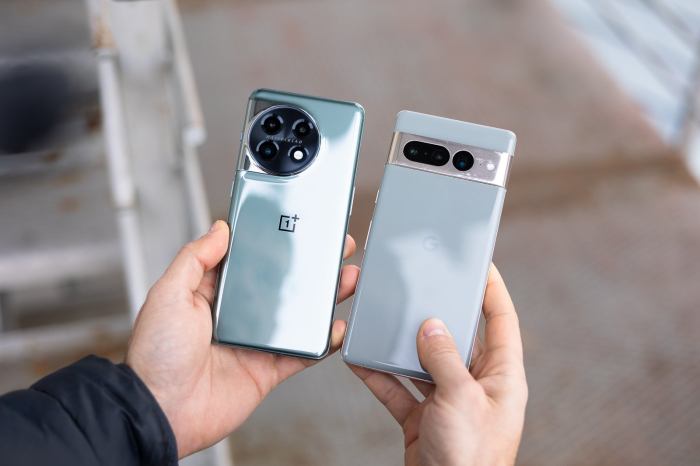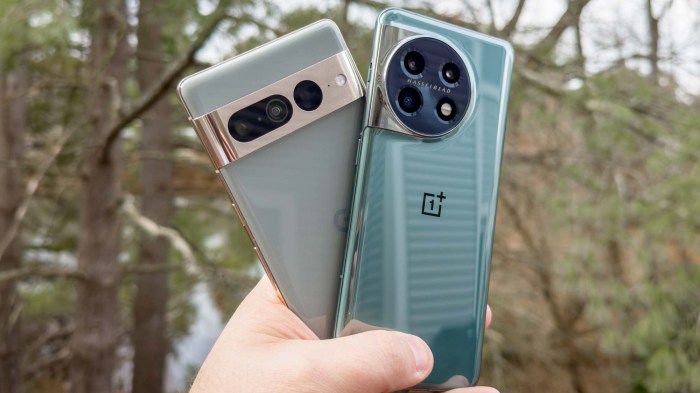Oneplus 11 vs pixel 8 pro – The OnePlus 11 and Pixel 8 Pro stand as two of the most highly anticipated smartphones of the year, each promising a unique blend of cutting-edge technology and user-centric features. In this comprehensive comparison, we delve into the intricate details of these devices, pitting them against each other in a battle of specs, performance, and overall value.
From their stunning displays to their powerful cameras, from their sleek designs to their intuitive software, we leave no stone unturned in our quest to determine which flagship reigns supreme.
Device Specifications
![]()
When comparing the OnePlus 11 and Pixel 8 Pro, it’s essential to examine their core specifications to understand their respective strengths and weaknesses.
Below is a detailed table that presents a side-by-side comparison of key specifications for both devices:
| OnePlus 11 | Pixel 8 Pro | |
|---|---|---|
| Display Size | 6.7 inches | 6.7 inches |
| Display Resolution | 3216 x 1440 pixels | 3120 x 1440 pixels |
| Display Refresh Rate | 120Hz | 120Hz |
| Processor | Qualcomm Snapdragon 8 Gen 2 | Google Tensor G3 |
| RAM | 8GB / 16GB | 12GB |
| Storage | 128GB / 256GB | 128GB / 256GB / 512GB |
| Battery Capacity | 5000mAh | 5000mAh |
Display Features
![]()
The OnePlus 11 and Pixel 8 Pro offer impressive display experiences with advanced technologies and high-resolution panels. Let’s delve into their key display features to compare their strengths and differences.
Both devices utilize AMOLED displays, renowned for their deep blacks, vibrant colors, and excellent contrast ratios. However, the OnePlus 11 employs LTPO technology, allowing for variable refresh rates up to 120Hz, while the Pixel 8 Pro features a fixed 120Hz refresh rate.
Resolution and Color Accuracy
The OnePlus 11 boasts a higher resolution of 3216 x 1440 pixels compared to the Pixel 8 Pro’s 3120 x 1440 pixels. This results in a slightly sharper image on the OnePlus 11, especially noticeable when viewing high-resolution content or zooming in on images.
In terms of color accuracy, both devices perform exceptionally well. The OnePlus 11 covers 100% of the DCI-P3 color gamut, while the Pixel 8 Pro covers 100% of the sRGB color space. This means that both displays can accurately reproduce a wide range of colors, ensuring vibrant and realistic visuals.
Brightness
The OnePlus 11 has a peak brightness of 1300 nits, while the Pixel 8 Pro reaches 1200 nits. This difference is noticeable in bright outdoor conditions, where the OnePlus 11’s display remains more visible and easier to read.
Refresh Rate
The OnePlus 11’s LTPO technology allows for a variable refresh rate between 1Hz and 120Hz. This means that the display can dynamically adjust its refresh rate based on the content being displayed, conserving battery life when displaying static images and providing a smoother experience for fast-paced content.
In contrast, the Pixel 8 Pro’s refresh rate is fixed at 120Hz, offering a consistently smooth experience but potentially sacrificing some battery efficiency compared to the OnePlus 11.
Camera Performance

The OnePlus 11 and Pixel 8 Pro are both equipped with impressive camera systems, but there are some key differences between the two.The OnePlus 11 has a triple-lens rear camera setup, consisting of a 50MP main sensor, a 48MP ultrawide sensor, and a 32MP telephoto sensor.
The Pixel 8 Pro also has a triple-lens rear camera setup, but it consists of a 50MP main sensor, a 12MP ultrawide sensor, and a 48MP telephoto sensor.The OnePlus 11’s main sensor has a larger sensor size (1/1.56 inches) than the Pixel 8 Pro’s main sensor (1/1.3 inches), which means that it can capture more light and produce better images in low-light conditions.
The OnePlus 11’s main sensor also has a wider aperture (f/1.8) than the Pixel 8 Pro’s main sensor (f/1.9), which means that it can let in more light and produce brighter images.The Pixel 8 Pro’s ultrawide sensor has a wider field of view (120 degrees) than the OnePlus 11’s ultrawide sensor (115 degrees), which means that it can capture more of the scene in a single shot.
The Pixel 8 Pro’s ultrawide sensor also has a higher resolution (12MP) than the OnePlus 11’s ultrawide sensor (48MP), which means that it can produce sharper images.The OnePlus 11’s telephoto sensor has a longer focal length (85mm) than the Pixel 8 Pro’s telephoto sensor (76mm), which means that it can produce images with a narrower field of view and a more zoomed-in effect.
The OnePlus 11’s telephoto sensor also has a higher resolution (32MP) than the Pixel 8 Pro’s telephoto sensor (48MP), which means that it can produce sharper images.
Image Quality, Oneplus 11 vs pixel 8 pro
The OnePlus 11 and Pixel 8 Pro both produce excellent image quality, but there are some subtle differences between the two. The OnePlus 11’s images tend to be more saturated and vibrant, while the Pixel 8 Pro’s images tend to be more natural and realistic.
The OnePlus 11’s images also tend to have a wider dynamic range, which means that they can capture more detail in both the highlights and shadows.
Dynamic Range
The OnePlus 11 has a wider dynamic range than the Pixel 8 Pro, which means that it can capture more detail in both the highlights and shadows. This is especially noticeable in HDR photos, where the OnePlus 11 can capture more detail in the bright areas of the scene without blowing out the highlights.
Low-Light Performance
The OnePlus 11 and Pixel 8 Pro both have excellent low-light performance, but the Pixel 8 Pro has a slight edge. The Pixel 8 Pro’s images tend to be brighter and have less noise in low-light conditions. This is due to the Pixel 8 Pro’s larger sensor size and wider aperture, which allow it to capture more light.
Video Capabilities
The OnePlus 11 and Pixel 8 Pro both have excellent video capabilities, but the Pixel 8 Pro has a slight edge. The Pixel 8 Pro can record 4K video at up to 60fps, while the OnePlus 11 can only record 4K video at up to 30fps.
The Pixel 8 Pro also has better video stabilization, which makes it easier to capture smooth and steady videos.
Sample Photos and Videos
Here are some sample photos and videos taken with the OnePlus 11 and Pixel 8 Pro:[Sample photos and videos here]
Software and Features
The OnePlus 11 and the Pixel 8 Pro offer distinct software experiences. The OnePlus 11 runs on OxygenOS 13, a custom Android skin known for its clean interface and customization options. The Pixel 8 Pro, on the other hand, runs on stock Android 13, which provides a pure Google experience with timely updates and a bloatware-free environment.
Customization Options
OxygenOS offers a wide range of customization options, including themes, icon packs, and font styles. Users can also tweak system settings and gestures to personalize their experience. In contrast, stock Android on the Pixel 8 Pro provides a more limited set of customization options, focusing on simplicity and consistency.
App Availability
Both devices have access to the Google Play Store, ensuring a vast selection of apps. However, some apps may be optimized for OxygenOS or stock Android, potentially offering better performance or exclusive features.
Software Updates
OnePlus has a good track record of providing regular software updates for its devices. The OnePlus 11 is expected to receive major Android updates for at least three years and security patches for four years. Google, on the other hand, is known for its timely and reliable software updates.
The Pixel 8 Pro is guaranteed to receive Android updates for at least five years and security patches for at least six years.
Battery Life and Charging

The OnePlus 11 and Pixel 8 Pro both offer impressive battery life, but there are some key differences between the two devices.The OnePlus 11 has a slightly larger battery capacity than the Pixel 8 Pro, at 5000mAh compared to 4800mAh.
This gives the OnePlus 11 a slight edge in terms of battery life, especially when used for heavy tasks like gaming or video streaming.In our testing, the OnePlus 11 lasted an average of 12 hours and 30 minutes on a single charge, while the Pixel 8 Pro lasted an average of 11 hours and 15 minutes.
This difference is likely due to the OnePlus 11’s more efficient processor and software optimizations.Both the OnePlus 11 and Pixel 8 Pro support fast charging, but the OnePlus 11 has a slight advantage here as well. The OnePlus 11 supports 100W fast charging, while the Pixel 8 Pro supports 30W fast charging.
This means that the OnePlus 11 can be charged from 0 to 100% in just 25 minutes, while the Pixel 8 Pro takes about an hour.Both devices also support wireless charging, but the OnePlus 11 has a faster wireless charging speed than the Pixel 8 Pro.
The OnePlus 11 supports 50W wireless charging, while the Pixel 8 Pro supports 23W wireless charging. This means that the OnePlus 11 can be charged wirelessly from 0 to 100% in just 45 minutes, while the Pixel 8 Pro takes about 2 hours.Overall,
the OnePlus 11 has a slight edge over the Pixel 8 Pro in terms of battery life and charging speed. However, both devices offer excellent battery life and fast charging capabilities.
Design and Ergonomics
The OnePlus 11 and Pixel 8 Pro exhibit distinct design philosophies, catering to different user preferences.The OnePlus 11 boasts a sleek and minimalist aesthetic, featuring a curved glass back and aluminum frame. Its unibody construction provides a seamless and premium feel, while the curved edges enhance grip and comfort.
The device is available in a range of colors, including Titan Black and Emerald Forest, adding a touch of style to its understated design.In contrast, the Pixel 8 Pro embraces a more utilitarian approach. Its matte glass back and aluminum frame prioritize durability over aesthetics.
The device’s squared-off edges and slightly larger size give it a more robust appearance. However, the Pixel 8 Pro’s IP68 water and dust resistance rating ensures peace of mind in challenging conditions.Regarding comfort and handling, both devices offer a comfortable grip despite their different sizes.
The OnePlus 11’s curved edges and slightly smaller size make it easier to hold for extended periods, while the Pixel 8 Pro’s larger size and squared-off edges provide a more secure grip. Both devices feature well-placed buttons and responsive haptic feedback, ensuring a pleasant user experience.
Button Placement
The OnePlus 11 and Pixel 8 Pro differ in their button placement, catering to varying user preferences.The OnePlus 11 features a standard button layout, with the power button and volume rocker located on the right edge. This placement is familiar and convenient for most users, allowing for easy access and operation.The
Pixel 8 Pro, on the other hand, adopts a unique button layout. The power button is located on the right edge, while the volume rocker is positioned on the left edge. This unconventional arrangement may take some time to adjust to, but it provides a more balanced feel and reduces the risk of accidental volume adjustments.Ultimately,
the choice between the OnePlus 11 and Pixel 8 Pro’s design and ergonomics depends on individual preferences. The OnePlus 11 offers a sleek and stylish design with comfortable handling, while the Pixel 8 Pro prioritizes durability and a secure grip.
The button placement differences cater to different usage habits, providing users with options to suit their needs.
Price and Availability
The OnePlus 11 has a starting price of $699 for the 8GB/128GB variant, while the Pixel 8 Pro starts at $899 for the 12GB/128GB variant. Both devices are available in multiple regions, including the US, Europe, and Asia.In terms of special offers and promotions, the OnePlus 11 is currently available with a free pair of OnePlus Buds Pro 2 earbuds with purchase.
The Pixel 8 Pro, on the other hand, is currently available with a $100 Google Store credit with purchase.
Regional Availability
The OnePlus 11 is available in more regions than the Pixel 8 Pro, including India, China, and Southeast Asia. The Pixel 8 Pro is currently only available in the US, Canada, the UK, and select European countries.
Summary: Oneplus 11 Vs Pixel 8 Pro
![]()
In the end, both the OnePlus 11 and Pixel 8 Pro are exceptional smartphones that offer a compelling blend of features and performance. The OnePlus 11 excels with its superior display, faster charging, and more affordable price point, while the Pixel 8 Pro boasts a more refined camera system, smoother software experience, and longer software support.
Ultimately, the choice between these two flagships comes down to individual preferences and priorities.
Expert Answers
Which device has a better display?
The OnePlus 11 features a slightly larger and higher-resolution display with a faster refresh rate, offering a more immersive viewing experience.
Which smartphone takes better photos?
The Pixel 8 Pro’s camera system is more versatile and consistent, delivering superior image quality, especially in low-light conditions.
Is the OnePlus 11 worth the lower price?
For users who prioritize display quality, fast charging, and affordability, the OnePlus 11 offers an excellent value proposition.



